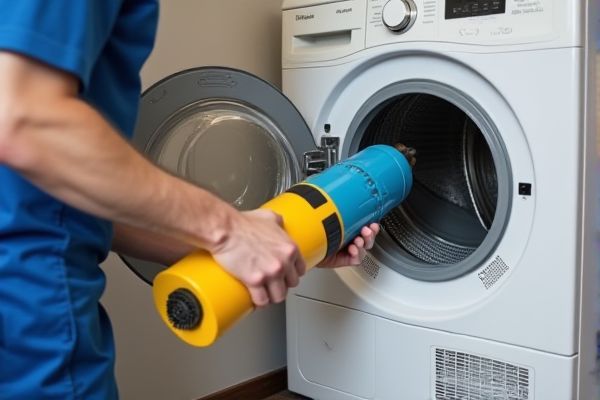
Automatic dryer vent cleaners provide efficient, consistent cleaning with minimal effort, reducing fire hazards and improving dryer performance, while manual vent cleaning relies on physical inspection and hand tools, which can be time-consuming and less thorough. Discover the pros and cons of each method to determine which best suits your needs and enhances your home's safety. Read on to learn more.
Table of Comparison
| Feature | Automatic Dryer Vent Cleaner | Manual Vent Cleaning |
|---|---|---|
| Efficiency | High - thorough and quick cleaning | Variable - depends on user skill and effort |
| Time Required | Minutes per vent | Often longer, 30+ minutes per vent |
| Cost | Higher initial investment | Lower cost, minimal tools needed |
| Ease of Use | Simple operation, less physical effort | Labor-intensive and requires tools |
| Effectiveness | Removes lint deep inside the vent | Surface lint removal only |
| Maintenance | Requires occasional device upkeep | No maintenance beyond cleaning tools |
| Safety | Reduces fire hazard risk | Moderate risk if not done properly |
Overview of Dryer Vent Cleaning Methods
Automatic dryer vent cleaners use motorized brushes or air pressure systems to quickly dislodge lint and debris, offering efficient and consistent maintenance. Manual vent cleaning relies on physical tools like scrub brushes and vacuum nozzles, requiring more time and effort but allowing detailed inspections. Your choice depends on convenience, budget, and the complexity of the vent's condition.
Importance of Regular Dryer Vent Maintenance
Regular dryer vent maintenance is crucial to prevent lint buildup, which significantly reduces dryer efficiency and increases the risk of fire hazards. Automatic dryer vent cleaners offer consistent, thorough cleaning by reaching deep into vents and removing debris more effectively than manual cleaning tools. Ensuring routine maintenance with either method extends dryer lifespan, lowers energy consumption, and enhances home safety.
How Automatic Dryer Vent Cleaners Work
Automatic dryer vent cleaners use rotating brushes powered by electric motors to remove lint and debris from vents efficiently, reducing fire hazards and improving dryer performance. These devices often include flexible rods that extend deep into the vent, ensuring thorough cleaning beyond what manual methods can achieve. Your dryer's efficiency and safety benefit significantly from the consistent, automated cleaning action provided by these systems.
Manual Dryer Vent Cleaning: Tools and Techniques
Manual dryer vent cleaning involves using specialized tools such as flexible brushes, vacuum attachments, and lint traps designed to reach deep into the vent system. Techniques include carefully rotating brushes to dislodge lint buildup and vacuuming out debris to prevent blockages that can cause fire hazards or reduce dryer efficiency. You can maintain optimal dryer performance and safety by regularly applying these hands-on cleaning methods to your vent system.
Efficiency Comparison: Automatic vs Manual
Automatic dryer vent cleaners offer superior efficiency by consistently removing lint and debris with minimal effort, reducing the risk of clogs and potential fire hazards. Manual vent cleaning requires regular physical labor and often misses hidden buildup in hard-to-reach areas, making it less reliable over time. Your dryer's performance and safety improve significantly when using automatic systems that maintain optimal airflow continuously.
Safety Considerations for Each Method
Automatic dryer vent cleaners reduce fire hazards by consistently removing lint and debris with minimal user exposure, enhancing safety through controlled, thorough cleaning. Manual vent cleaning requires careful handling to avoid damage to ducts and potential injury from sharp vents or dust inhalation, demanding vigilant use of protective gear and proper technique. You should weigh the safety benefits of automated precision against the risks inherent in manual methods to choose the most secure option for your home.
Cost Analysis: Initial Investment and Long-Term Savings
Automatic dryer vent cleaners typically require a higher initial investment, often ranging from $150 to $400, while manual vent cleaning tools cost between $20 and $50. Over time, automatic systems provide long-term savings by reducing energy bills and minimizing the risk of costly fire damage through consistent maintenance. Your choice impacts both upfront expenses and ongoing efficiency, with automatic cleaners offering better value for frequent use.
Time and Convenience Factors
Automatic dryer vent cleaners significantly reduce the time required for thorough maintenance by using motorized brushes and rotating mechanisms to efficiently remove lint buildup. Manual vent cleaning demands more effort and can take considerably longer, as it relies on hand tools and careful inspection to avoid damage. Choosing an automatic system enhances your convenience and ensures more consistent cleaning, helping to protect your dryer's efficiency and safety.
Suitability for Residential vs Commercial Use
Automatic dryer vent cleaners are highly suitable for commercial use due to their efficiency in handling large volumes of lint and debris, ensuring consistent maintenance and reducing fire hazards in high-traffic facilities. Manual vent cleaning is typically more appropriate for residential settings, offering a cost-effective solution for occasional maintenance and smaller duct systems. Commercial environments benefit from the automated technology's ability to perform frequent, thorough cleanings without extensive labor, while residential users often prefer manual methods for their simplicity and lower upfront costs.
Choosing the Right Dryer Vent Cleaning Solution
Automatic dryer vent cleaners provide efficient, consistent cleaning by using rotating brushes and powerful suction to remove lint and debris, reducing fire hazards and energy costs. Manual vent cleaning requires hands-on effort, often involving flexible rods and vacuum attachments to reach and clear blockages, suitable for homeowners seeking a cost-effective but labor-intensive method. Selecting the right solution depends on factors like budget, frequency of use, and the complexity of the vent system, with automatic cleaners ideal for frequent maintenance and manual methods fitting occasional, do-it-yourself cleaning needs.
 homyna.com
homyna.com